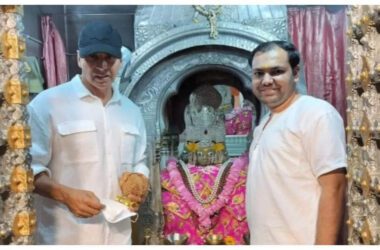Right in the middle of the exhibition “Giants: Art from the Dean Collection of Swizz Beatz and Alicia Keys,” which opens Saturday at the Brooklyn Museum, is Kehinde Wiley’s 25-foot-long 2008 painting “Femme Piquée par un Serpent.” Showing a Black man in snappy but casual dress reclined in a distinctively twisted position, with a background of Wiley’s signature flowers, it borrows both title and pose from an 1847 marble sculpture by Auguste Clésinger. What you think of it really depends on what you’re asking for.
If you view the painting as a Venti-size iteration of Wiley’s ongoing project, his decades-long attack on the paucity of Black faces in Western museums and art history, it’s one-note but hard to argue with. Brightly colored and thoughtfully composed, it’s visually appealing, and even today, when it’s no longer so uncommon to see Black figures on museum walls, catching sight of one this big still elicits a thrill.
On the other hand, considered strictly as a painting, “Femme Piquée par un Serpent” (“Woman Bitten by a Serpent”) doesn’t offer that much. There are no details that you’d miss in a jpeg reproduction, no visible evidence of human hands at play, no sensual pleasure to be found in the surface, nothing surprising, mysterious or engrossing. It’s simply the adept illustration of an idea.
Of course, you could also ask for both — for a clear conceptual work about painting (and the historical exclusion of Black subjects and artists) that is also a good painting. If you do, you’re likely to respond to “Femme Piquée par un Serpent” with ambivalence and frustration.
I was thinking about this — about artistic endeavors that succeed and fail at the same time — as I walked through “Giants,” the latest celebrity tie-in exhibition at the Brooklyn Museum. (“Spike Lee: Creative Sources” closes on Sunday; a show of photographs by Paul McCartney opens in May.) “Giants” draws on the extensive art collection of the married musical superstars Keys and Beatz (Kasseem Dean), bringing together 98 works — many oversized and of recent vintage — by 37 artists. Most of them are American, but they also come from several countries in Europe and half a dozen in Africa, and they range in generation from Ernie Barnes, who died at 70 in 2009, to Qualeasha Wood, born in 1996.
Stylistically, however, it would be hard to imagine a more narrowly focused show. That nearly all the faces are Black, or that wherever there’s a political subtext, it involves an issue of special concern to Black Americans, is great. But that the work is also nearly all figurative, that so much of it is of a similar size, made with similar colors, composed in the same way and hung in the same way, is not so great. So many superficial resemblances have a flattening effect. It becomes hard to appreciate the nuance, or individuality, of a piece that at first blush looks like just a greener or redder version of the piece to its left.
If you can tune out this flattening effect, you will find quite a few excellent artworks from the collection. (The show is in the museum’s special exhibition space on the ground floor, which means you will also have to pay $25 per adult to get in.) They include vibrant paintings that the South African artist, Esther Mahlangu, makes with traditional Ndebele house patterns; Arthur Jafa’s overwhelming, 7,000-pound truck-tire sculpture “Big Wheel I”; a rich, room-size polyptych by Meleko Mokgosi; and 14 charming, oval and round landscapes of Jamaica by Barkley L. Hendricks.
There’s a whole wall of black and white photographs by Gordon Parks, including both well-known images of Malcolm X, Muhammad Ali and Langston Hughes and sensitive photographs of less famous faces, and a facing wall of Jamel Shabazz’s more candid color photographs of well-dressed Brooklynites and early hip-hop pioneers. Deana Lawson’s oversize staged photos of domestic interiors, hung together on yet another wall, are as unnerving and powerful as ever. These all would have been more effective hung around the exhibit instead of crammed together in a commercial-looking display, but the photographs themselves rarely miss.
A soundsuit by Nick Cave is reliably delightful, as is Jordan Casteel’s portrait of the clothing designer Fallou Wadje selling T-shirts in Harlem, and Hank Willis Thomas contributes an incisive 2017 textile piece called “You Shouldn’t Be the Prisoner of Your Own Ideas (LeWitt).” An eight-foot square of green and white stripes with an X in the middle, it’s made of decommissioned prison uniforms.
Before you get to any of this, however, you have to pass through a kind of shrine to the collectors.
There’s a larger-than-life photograph of Keys and Beatz in formal wear, posing with a BMX bike. And several actual bikes from Beatz’s collection. And his turntables. And the piano Keys used in her 2014 video “We Are Here.” And portraits of the couple by Wiley, Derrick Adams and Shabazz, who shot them re-enacting a somber 1970 Gordon Parks photo of the Black Panther leader Eldridge Cleaver with his wife, Kathleen, in Algeria. Once you do get to the art, you’ll find it interspersed with little lounge areas surrounded by Bang & Olufsen speakers, the couple’s preferred brand, playing a special playlist compiled by Beatz, as if the couple had invited you to one of their houses to see what was on their walls.
The show’s first text asserts that Beatz and Keys have “stood as giants in our cultural landscape for decades”; it doesn’t mention that Beatz was on the museum’s board until late last year, when he resigned to avoid the appearance of a conflict of interest, nor had it been announced at press time which pieces, if any, the couple plan to donate to the museum.
What you say about all this depends, again, on your expectations. Is the point of the whole show to demonstrate how many talented Black artists there are in the world? Or to give a boost to some of the younger and lesser known of them? Those are important goals and it would be hard to claim that “Giants” didn’t fulfill them. You could even imagine that the over-the-top hype of Keys and Beatz — who are influential artists in their own right — is meant to serve as a similar kind of demonstration. Or is the point simply to keep the museum’s lights on by getting visitors in the door? Given the current climate, I couldn’t argue with that, either.
Still, you can’t help but wonder if the same point couldn’t have been made in a less aesthetically claustrophobic way, a way that dispensed with hagiography and left more room for the subtlety, the depth and the sheer complexity possible in visual art. After all, isn’t that what museums should be sharing with new audiences in the first place?
Giants: Art from the Dean Collection of Swizz Beatz and Alicia Keys
Feb. 10 through July 7, the Brooklyn Museum, 200 Eastern Parkway, Brooklyn, (718) 638-5000; brooklynmuseum.org.
Source link







![Growing up learning Indian Classical Music, I’ve developed a deep appreciation for diverse musical genres, and techno is definitely one that has captured my interest. Got inspired to write this track by blending the beautiful melodies of Hindustani classical, particularly Raag Bhairav, with the beats of techno. Excited to share this fusion with you all!
Music by @miladzki
Check it out and vibe with me! 🎶✨
[ techno, newmusic, fusion, indianclassicalmusic, techno, music, kakisinger ]](https://b2989647.smushcdn.com/2989647/wp-content/uploads/wp-social-ninja/instagram/9xm.tv/18327743320185528_full.jpg?lossy=1&strip=1&webp=1)
![Listen to this Version of Dil Kho Gaya
Original Song From the Movie Dil.
Anand-Milind, Udit Narayan, Anuradha Paudwal sung this song
Music by Anand-Milind
Hope you guys like this Rendition of the Classic Song by Kaki Singer.
Like, Share & Comment.
[ Dil, Dil kho Gaya, old songs, Classic Bollywood, old song covers, retro songs, indian old songs, old hindi songs, melodies, kaki singer, Indian singers ]](https://b2989647.smushcdn.com/2989647/wp-content/uploads/wp-social-ninja/instagram/9xm.tv/17999564600299237_full.jpg?lossy=1&strip=1&webp=1)






















































